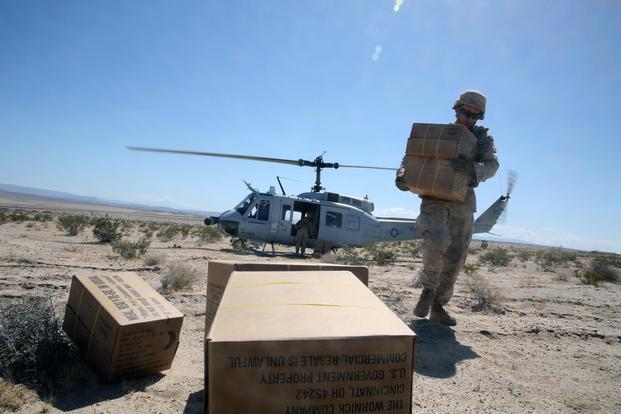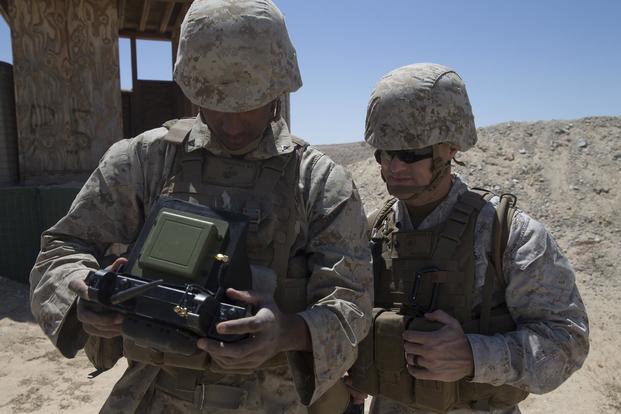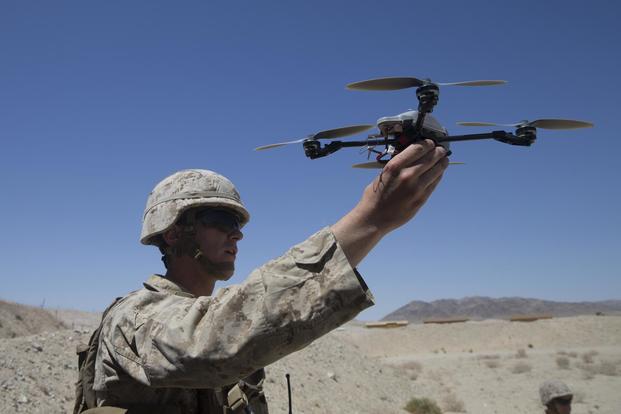QUANTICO, Va. -- A Marine Corps logistics unit will use two big upcoming training events to test innovative new ways to quickly deliver supplies to ground forces -- all while minimizing the risks to everyone involved.
Logisticians could soon turn to heavy-lift drones, 3-D printing and self-driving vehicles to distribute vital supplies -- think ammunition, medical gear, replacement parts or food -- to small teams of ground troops operating far from forward-operating bases or Navy supply ships.
Members of North Carolina-based Combat Logistics Battalion 8 have been tasked with testing the new equipment at Marine Corps Ground Combat Center Twentynine Palms in California. They're gearing up for two massive exercises to further press the concepts: a full Marine expeditionary force-level event in the States and Trident Juncture in Norway, which will include 35,000 NATO troops, 70 ships and about 130 aircraft.
The exercises are just part of a years-long effort called Sea Dragon 2025, designed to improve Marines' survivability in hotly contested environments when facing off against enemies with high-tech capabilities.
"We've executed a series of war games focused on defending our networks, managing our signature in complex and challenging environments, projecting and sustaining our force in contested environments over extended ranges, and operating as an integrated naval force," Brig. Gen. Christian Wortman, head of the Marine Corps Warfighting Lab, told reporters here Thursday. "The lessons in each one of these areas are profound and are being immediately rolled into our future-force development efforts."
The experimental MEF-level exercise will take place before the end of September. Trident Juncture kicks off in October.
While at Twentynine Palms, the CLB-8 Marines have used the Autonomous Aerial Cargo Utility System, an unmanned UH-1 Huey helicopter that's controlled by a handheld tablet. Once loaded, the helo drone finds the optimal route to reach its target, lands and then returns to base when the resupply is complete.
It's a welcome alternative to dangerous convoys or manned aircraft missions, according to a Defense Department release on the aircraft's capabilities. It won't leave Marines and other troops facing the threat of bad weather or roadside bombs.
The CLB-8 Marines also dropped off a box of Meals, Ready to Eat from an unmanned quadcopter, used handheld drones for reconnaissance missions and tested self-driving vehicles.
The Marines were trained on how to use the near gear, but leaders encouraged them to be creative about how they put it to use, said Maj. Steve Shull, a hybrid logistics project officer with the Warfighting Lab's experiment division.
"When you give it to a young Marine, he or she will be innovative," he said. Those on the ground understand the problems they're facing and often come up with ways to employ the gear that wasn't previously considered, he added.
Maj. J.B. Persons, a special projects officer with the Warfighting Lab's science and technology division, agrees. They want to give Marines a starting point as to how they might use new technology, but it should serve only as a point from which to deviate, he said.
"Give Marines new tools or toys, and they will surprise you every time," Persons said.
The logisticians are also experimenting with making parts right in the field using 3-D printers, which could cut down on the wait times Marines face for vital repairs or replacement parts.
"You want to figure out what are the biggest cost drivers and what are the biggest readiness degraders," Wortman said. "... What we're trying to demonstrate is additive manufacturing in expeditionary or austere environments is viable and that we're able to produce parts to a sufficient standard that they can be applied in a way that allows us to tighten up our supply chain."
CLB-8 is the second Marine unit to conduct this level of experimentation as part of Sea Dragon 2025. Last year, members of 3rd Battalion, 5th Marines, a California-based infantry unit, took on similar experiments with self-driving tanks, robots, drones and other gear.
Next year, Wortman said, the experiment will be centered on information warfare. The Marine Corps recently created a new information group meant to help protect command-and-control networks and cyberspace vulnerabilities. Now they'll go a step further in figuring out how to protect Marines' signature when they're in the field and combat the use of information as a weapon.
All of this will help the Marine Corps operate "small, fast and lethal," Wortman said. Marines need to be able to move seamlessly to and from the sea as well as maneuver quickly to different points on land.
And the service is not "standing still" when it comes to addressing some of the future threats Marines are likely to face, Wortman added.
"We're turning these lessons into programs or continued experimentation, and we're implying the insights gained to much larger formations over much greater ranges," he said.
-- Gina Harkins can be reached at gina.harkins@military.com. Follow her on Twitter at @ginaaharkins.















